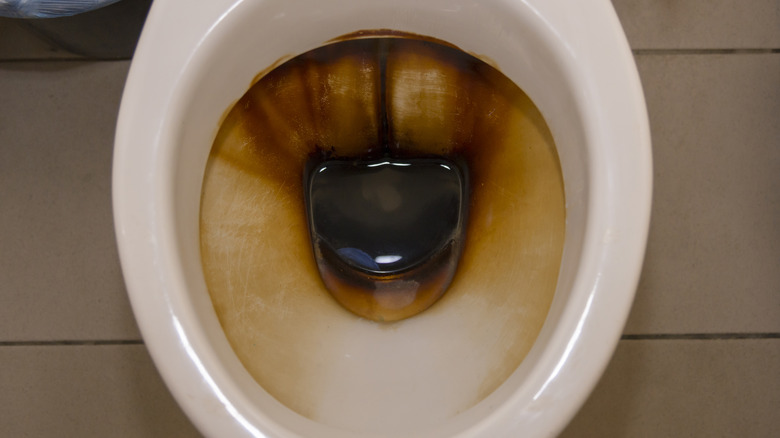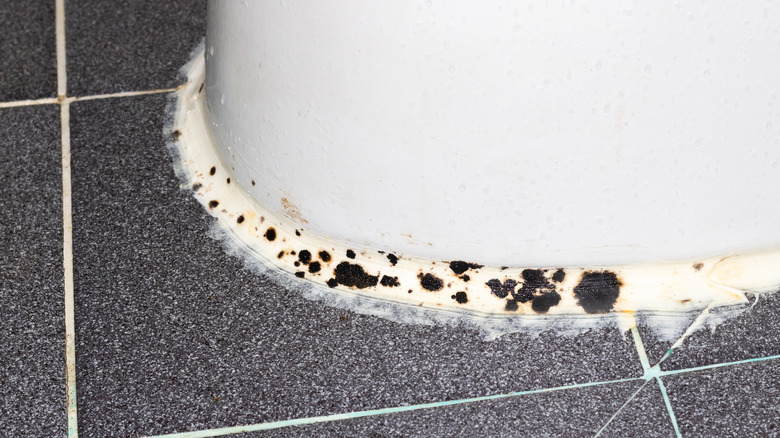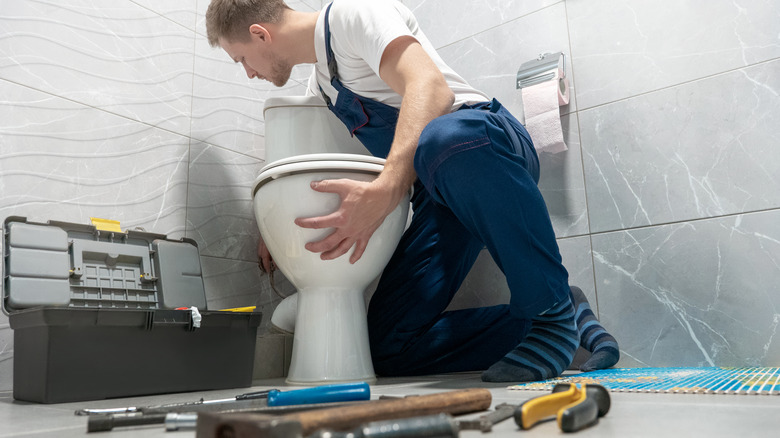What It Means If Your Toilet Water Is Black (And Why It's Important To Act On It)
Black water in your toilet can be an alarming sight. Once you've noticed, you might be reluctant to deal with it — honestly, what could be less pleasant? — but it's important to get to the root cause right away. You may be dealing with mold growth or something more serious, like sewage backup. Whether the cause is bacteria or a plumbing issue, you don't want to leave discolored water unchecked. Failing to act on it may put your health at risk and lead to bigger problems down the line.
Toilets tend to attract fungi due to the water inside the bowl. One of the biggest mistakes everyone makes with their toilet is failing to clean it regularly, so if black water rears its ugly head, start by giving your toilet a deep cleaning. This may be all it takes to restore the water back to normal. Or, in more severe cases, you may need to call for emergency repairs. Let's get into the most common causes of black toilet water, how to identify the source of your issue and the steps you can take to address it.
The underlying causes of black water in your toilet bowl
Black toilet water often signifies unwanted fungal (and/or bacterial) visitors. If you have black mold growing in your toilet, you may also notice fuzzy dark spots on the base, seat, and rim, as well. Because of the stagnant water inside, your toilet bowl will attract mold if it's not used or cleaned regularly. A poorly ventilated bathroom and plumbing leaks can also cause mold growth. Breathing in mold can lead to symptoms like coughing, congestion, and even respiratory issues over time, so you should never let it linger and get rid of it ASAP.
While mold and bacteria can be eliminated rather quickly, a more serious cause of black toilet water is not as easy to fix. Sewer backup problems can cause dark water to run into your home's plumbing system. If the water in your toilet has a sewage-like odor, call an emergency plumber right away. Exposure to contaminated water full of germs can be harmful to your health, as well as your plumbing system.
Another cause of black stains inside your toilet bowl and tank is high levels of a mineral called manganese, which could be present in your home's water supply. Manganese is not necessarily harmful to your health; in fact, we need to consume manganese through food to stay healthy. But too much of this mineral in your water could damage your appliances over time, in addition to causing that black color.
The best ways to take action and prevent black toilet water
If you're struggling to get to the bottom of your toilet's issues, you may need to call a plumber or water treatment specialist for help. If you've established that mold is the cause, cleaning black mold in your toilet is relatively easy. The first step is to ventilate your bathroom and grab some protective equipment, such as a mask and gloves. Mix together a solution of equal parts water and either bleach or vinegar and baking soda.
Scrub all of the moldy areas thoroughly with a brush and let the solution sit for a short time, before rinsing it off and flushing. In addition to regular cleaning and ventilation, it's important to assess your toilet for leaks and cracks, as these could cause the mold to return.
If you suspect that the cause of your black toilet water is excess manganese, consider having your home's water supply tested by a specialist. You can choose from a number of treatment solutions, such as water softeners and filters, to cut down on mineral deposits. Meanwhile, unless you're a plumber yourself, don't try to fix sewage issues — contact a professional immediately if you suspect that backup is contaminating the toilet bowl. When in doubt, consult a professional to help you choose the best treatment options for your home.


